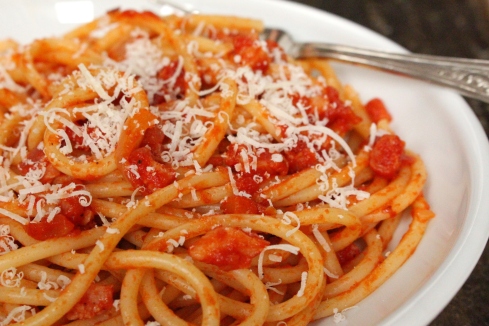Gnocchi di patate (potato dumplings) is an Italian classic. These dumplings are small pieces of potato dough, usually round or oblong in shape, which are boiled in water and then served with various toppings such as tomato sauce and fresh basil, oil olive and grated Parmesan cheese, Bolognese sauce or even Brasato al Barolo sauce. I personally like gnocchi (pronounced gnawk-KEY) with tomato sauce because the fresh taste of the tomato and basil blends well with the starchiness of the potatoes. The texture is soft, and the simple ingredients are just potatoes, flour and egg. The taste, though, is delicate and inviting. Gnocchi is an easy, fast and light recipe to prepare, although you do need to take care in minimizing the amount of flour used. You can enjoy this dish as first course (like we Italians do) or as a main dish, if you prefer. It is an excellent vegetarian dish (it does contain eggs and dairy products, though). I grew up making gnocchi al cucchiaio (a typical Lombard recipe) with my mom, especially on Friday. It was part of our Friday meal, as it is in Verona, especially during the Carnival. In fact, gnocchi is considered a weekday dish; in Rome it is frequently served on Thursday. In Naples, though, it is known as a festive dish on Sunday. At the time the Americas – and potatoes – were discovered by the Europeans, some varieties of dumplings were already present in the Old World, especially in Lombardy. They were prepared by mixing bread crumbs, milk and almonds and were called Zanzarelli. In the seventeenth century, however, the original recipe underwent some changes in both the composition of ingredients and in its name: it took the name of malfatti and flour, water and eggs were used instead of almonds and bread. With the introduction of potatoes from the Americas, the popularity of potato gnocchi spread and slowly some of the previous varieties disappeared.
GNOCCH DI PATATE AL POMODORO (POTATO DUMPLINGS WITH TOMATO SAUCE)
Preparation time: 1 h tomato sauce + 20 min. gnocchi Serving: 4

INGREDIENTS
Tomato sauce
900 g (2 pounds) ripe S.Marzano or Roma tomatoes peeled and coarsely chopped
1 medium onion, finely chopped
2 garlic cloves, finely chopped
1 carrot, finely chopped
1 celery stock, finely chopped
2 tablespoon olive oil (Extra Virgin)
5-6 basil leaves
Salt and freshly ground pepper to taste
Gnocchi
900 g (2 pounds) unpeeled potatoes (Patate a pasta gialla di Avezzano, Yukon Gold potatoes)
240 g (1 ½ cups) all-purpose flour
1 egg
1 tablespoon olive oil (Extra Virgin)
Salt to taste
Greated Parmesan cheese to serve
DIRECTIONS
Tomato sauce
1. In a large, heavy sauce pan, heat the oil over medium heat and sauté the all vegetables except the tomatoes for about 2-3 minutes
2. Add the tomatoes and the basil
3. Cover with a lid and cook for about 30 minutes; remove the lid and cook for additional 20 minutes, stirring occasionally
4. Puree the sauce with a blender. Season with salt and pepper. Set aside and keep warm.
Gnocchi al cucchiaio (Gnocchi using the spoon method)
1. Cook the potatoes until just tender either by boiling or baking. The potato flesh for gnocchi should be dry, therefore it is better to boil the potato in the skin to prevent water absorption. Drain well and set aside until just cool enough to remove the skin. The potatoes should be warm, otherwise the flour and the potato puree will not bind with the egg
2. Put the warm potatoes through a potato ricer (never a mixer) into a bowl, season to taste with salt. Add the egg and olive oil, incorporate the flour and mix just enough until the dough is formed. Be careful not to overwork it; the dough will be lighter and the texture softer if you are able to minimize the flour used)
3. Bring a large pot of salted water to a slow boil. Drop teaspoon-sized balls of dough in the boil water
4. The gnocchi are done as soon as they float to the top, after only about 10-15 seconds (no longer or they will fall apart in the water!!). Remove with a slotted or spider spoon and place on a preheated serving dish. Repeat with the remaining dough and toss gently with the tomato sauce and grated Parmesan cheese.
5. Before cooking the whole batch, I recommend making a couple of test gnocchi to see if the dough holds together. The cooked gnocchi should be firm but not tough and should not fall apart in the water. If they fall apart, you should add 1-2 tablespoons of flour. If they are tough, then you’ve used too much flour! I find that the spoon method is easier and requires less flour in comparison to the rolling method, thereby allowing you to make very tender gnocchi.
Note: The type of potatoes is crucial (I strongly recommend to use patate farinose, rich in starch), as well as the use of a potato ricer, which lets the steamy moisture out of the hot potatoes. In case fresh tomatoes are not available, try using S. Marzano canned tomatoes. One final note of caution … make sure you don’t mispell or mix up the term gnocco (singular of gnocchi) with gnocca, which means a “hot woman”!!!! 😉 -Paola
Tags: Dumplings, Gnocchi, Parmesan cheese, Potatoes, S. Marzano tomatoes








